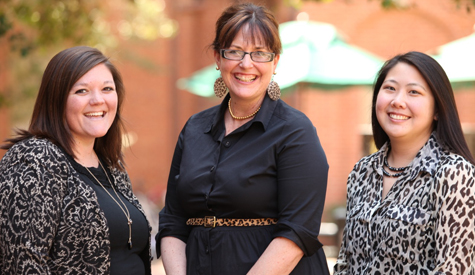W&M adopts new approach to developing student leaders
How can William & Mary best develop student leaders?
Anne Arseneau, director of the new Office of Student Leadership Development, intends to find out. For the past nine months she’s been leading a charge on campus to examine a new philosophical approach with the goal of providing all students on campus meaningful opportunities for leadership development.
“It’s really a change in how we’re working within student affairs,” said Arseneau. “Our new thematic unit of Student Engagement and Leadership recognizes leadership as a vital component of a well-rounded college education and aims to serve students and promote their success and personal growth.”
This new approach stems from the thematic reorganization of the Division of Student Affairs, which occurred last July under the leadership of Vice President for Student Affairs Ginger Ambler. Five thematic units were created: Engagement and Leadership, Health and Wellness, Campus Living, Student Success/Dean of Students and Career Development.
“The goal in all of this has been to align our staff, offices and priorities with the broad mission and vision of the College, and in the best interest of the students we serve,” Ambler wrote in an email announcement to her staff.
Arseneau, who has worked within the department formerly known as Student Activities since 1997, now oversees all the separate areas within the department, including formal leadership training, clubs and organizations, the student programming board, student publications and fraternity and sorority life.
“Whereas before our lens of student leadership was decentralized, we are now all engaged around the concept of student leadership development,” she said.
“It’s a very different thought process to support an event versus supporting students who are working toward a cause, or for a change, which at some point involves an event. What these students learn about their leadership capabilities is really what we’re after.”
William & Mary is well-known for taking the lead in educational achievement and innovation, from being the first American college with a Royal Charter to creating the first Greek-letter society Phi Beta Kappa, founded in 1776. The focus to create a comprehensive leadership program inspires the development, awareness and recognition of leadership throughout the W&M community, said Arseneau.
In February, the university hosted the first Leadership Summit, sponsored by Shirley Hollen ’54. More than 40 students, alumni, faculty, staff and community leaders gathered for a day-long event in which they discussed the common language of leadership, reviewed the latest theories and conducted a strategic planning session that examined what is known about leadership at W&M and how the university can build its own distinctive leadership model.
The summit followed on the heels of recommendations made by the Vice President’s Working Group for Student Leadership Development. Charged by Ambler last fall, the campus-wide group consisted of faculty, staff, students and alumni who met for eight consecutive weeks to conduct a thorough review on leadership at the university.
“Rather than working off of a list of suggested programs, which could potentially limit the creative process, the working group was unhindered and given the opportunity to imagine and carve out the best possible model for our campus,” said Arseneau.
What they found, said Arseneau, is that approaches to student leadership development are more successful when they are linked to known theories and models.
“We also discovered that many students view leadership as only a formal position with an organization,” she said. Reflection and mentorship to help students understand their experiences were also key findings, Arseneau added.
Members of the working group also conducted site visits to regional colleges with student leadership development programs. In January, the nine-member team traveled to the University of Maryland and George Mason University to meet with faculty and staff within the academic field of student leadership.
Drew Stelljes, assistant vice president for student engagement and leadership, said that one way students can learn and experience both the theory and practice of leadership is through coursework. This semester Stelljes taught a course entitled, “Leadership and Community Engagement.” The course was designed for students to learn about the most effective leadership strategies from the nation’s most successful community change makers, such as prominent leaders in government, education, non-profits, law and international relations.
“Our shared vision in Student Affairs is to support our students so that they will graduate with a greater capacity to be leaders; they will be more marketable to potential employers and desirable in any community,” said Stelljes. “Our intentions are for the new office to be a clearinghouse for leadership on campus – a ribbon that weaves throughout campus helping all students.”
Arseneau said she and her colleagues are developing a white paper designed with a series of programs, speakers, events, trips and curricula to enable William & Mary students to become better prepared to assume leadership in work and in the community.
“We want our students to gain the skills to change the world and we imagine our graduates doing just that,” she said.
“We also aspire to be a national model for student leadership development by 2018. There’s more work to be done, but there’s no better place to cultivate student leadership development than at the College of William & Mary.”
















